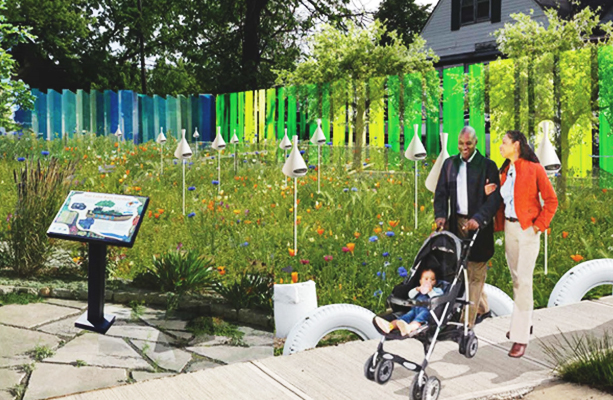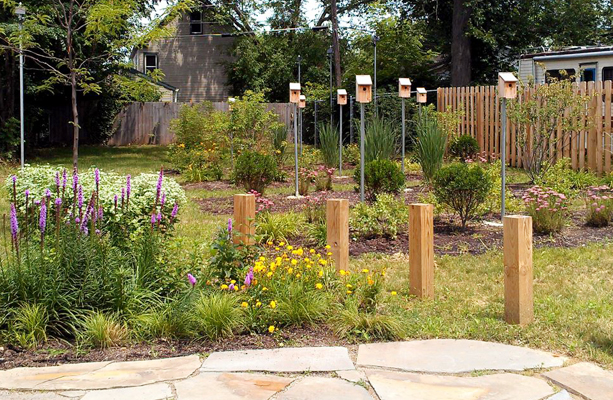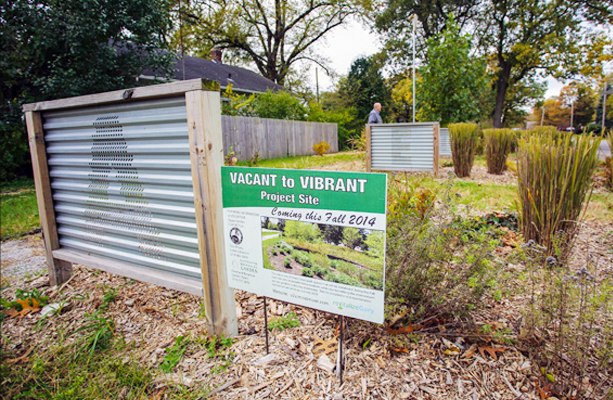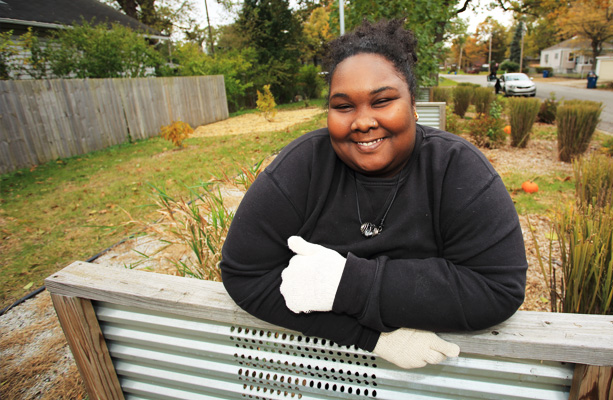Prototyping Great Lakes—Friendly Neighborhoods of the Future
Vacant to Vibrant: Stormwater Solutions that Fight Urban Blight
- By Randall Hyman
In recent decades, cities across the Great Lakes region have been hit with the triple threat of heavier precipitation, aging infrastructure, and weak economies. The infrastructure in many cities needs costly investment and affordable solutions are in high-demand as communities struggle with stagnant economies and slow-growing, or even shrinking, populations. And in cities hard-hit by job loss and foreclosure, abandoned properties blight neighborhoods with clear evidence of decline.
Seeking Green Solutions
In 2012, three innovators from the Cleveland Botanical Garden drove from Milwaukee to Toronto to see how Great Lakes cities were repurposing vacant lots.
“Around the same time, the EPA and USGS had been studying how small residential vacant lots could absorb stormwater,” recalls Sandra Albro of their Great Lakes tour, “and they actually found that they absorbed larger quantities of stormwater than expected.”
Taking a cue from those studies and borrowing from their own successes with urban farming in Cleveland, Albro and her colleagues had an idea. In contrast to expensive, large-scale sewer remediation projects, they wondered if a way to undo urban blight while also controlling stormwater was to unravel it the same way it evolved: lot by lot, block by block. The hope was that small parcels of improvement would inspire locals and spread change from within neighborhoods.
In 2013, with an investment of $902,000 from the Great Lakes Protection Fund, the trio launched the Vacant to Vibrant (V2V) project in Cleveland, Gary, and Buffalo, focusing on placing green infrastructure to attain not only environmental, but also social and economic benefits.
Building a New Approach
The V2V team—which included scientists, neighborhood residents, civic groups, utilities, and local government officials—began their site selection process with a new top-down approach. Instead of starting with small-scale functionality, they began by looking at characteristics that would benefit larger-scale systems (like a watershed)—systems of which these lots would be a functioning part.
First, they built a series of questions that led the team to the lots that mattered most to the water environment. (Some lots can solve many water problems, some less, even if they have the capacity to store similar amounts of water.) Second, they built a systematic approach to find lots that offered higher benefits in terms of neighborhood stabilization (e.g. providing new green space, investing in under-served communities).
Combining these tools maximized the impact of the green infrastructure in terms of ecosystem outcomes (which happened outside of the neighborhood) and in terms of quality of life outcomes within the neighborhood.


These tools, made widely available by the team, could be applied similarly in many cities in the Great Lakes region. Each V2V city yielded valuable ecological and social takeaways, but Gary, Indiana was a particular success.
Growing Green
At first glance, Gary is not a place along the Great Lakes one might turn to for environmental inspiration. Named in 1906 after the founder of U.S. Steel, Elbert Henry Gary, the city is punctuated by aging steel mills and a legacy of water and air pollution. Within Gary’s 52 square miles stand more than 7000 vacant and abandoned properties, among which are one third of its homes.
“We are overwhelmed in terms of managing vacant spaces,” says Brenda Scott-Henry director of Gary’s Environmental Affairs division, “but we can’t give up.”
Working closely with Albro, Scott-Henry has grown fond of the three V2V lots in Aetna, a planned community for steel workers that is now one of Gary’s poorer neighborhoods. She walks amid rain gardens and landscaping swales in a park-like lot on a corner where a burnt-out, two-bedroom home once stood. Five washboards stenciled with the letters A-E-T-N-A stand in a row amid plantings that are both decorative and useful.

“Topography is important,” she says. “You see the slope here? If it rains too much, the water will flow right into that rain garden and stay out of the street. There’s a lot of opportunity associated with these properties.”

At each of Aetna’s V2V lots, she looks for any hint of trash or neglected maintenance, but the parcels are neat and clean. Local residents have taken pride in the lots and picked up where the city left off, especially at this grassy corner park.
Across Gary, many green infrastructure projects are in place, notably the 30-mile Green Link Trail that will eventually loop around the entire city connecting the Lake Michigan shoreline to the Grand and Little Calumet Rivers.
“We took the best practices from Vacant to Vibrant and we’re applying them to other green infrastructure projects,” says Scott-Henry.
Prototyping Neighborhoods
In long-neglected neighborhoods like Aetna, where urban renewal has been paired with stormwater control, projects like V2V are spreading hope—lot by lot, block by block—and giving cities in the Great Lakes and other regions a road map for building green infrastructure, revitalizing communities, and improving the way water moves through urban landscapes.
Albro has written a book on the five-year project which was released in April 2019. It contains a primer of dos and don’ts for urban planners confronted with tackling both urban decay and curbing stormwater runoff. Albro offers her experiences creating infrastructure networks and facilitating more equitable access to green space.
Cover Photo: Rendering by Jason Kentner and Sean Burkholder
—
Start a Conversation
At the Fund, our goal is to build something—together—that delivers impact. You have an idea and a strategy in mind and we have a basin-wide perspective and experience launching new initiatives. We strongly encourage you to contact us to discuss an idea, whether fully formed or not, as a first step.
Email us at startaconversation@glpf.org